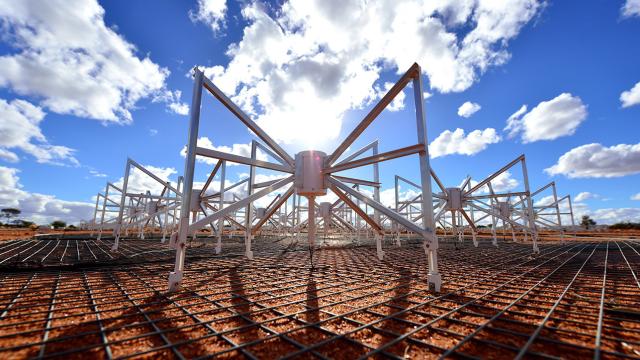A groundbreaking survey of over 10 million star systems has failed to detect signs of extraterrestrial intelligence.
Astronomers working with the Murchison Widefield Array (MWA) radio telescope in Western Australia were unable to detect alien technosignatures while surveying millions of star systems in the Vela constellation, according to new research published in Publications of the Astronomical Society of Australia. The authors of the new study, Chenoa Tremblay from CSIRO and Steven Tingay from the International Centre for Radio Astronomy Research (ICRAR), were hunting for low radio frequencies similar to those produced by our own civilisation.
Located in a radio-quiet zone of the Australian outback, the MWA, with its 256 array tiles, has a frequency range between 80 and 300 MHz.
“The MWA is a unique telescope, with an extraordinarily wide field-of-view that allows us to observe millions of stars simultaneously,” explained Trembley in a Curtin University press release. “We observed the sky around the constellation of Vela for 17 hours, looking more than 100 times broader and deeper than ever before. With this dataset we found no technosignatures — no sign of intelligent life.”
The astronomers were searching for radio waves between 98 and 128 MHz, as these “narrow band signals” are “consistent with radio transmissions from intelligent civilisations,” according to the new study. Of course, we remain the only intelligent civilisation known to produce these sorts of radio signals, but aliens, if they exist, likely produce them as well.
This latest SETI endeavour was conducted in January 2018 and included a region of space known to contain at least six exoplanets. To date, MWA has examined 75 known exoplanets at low frequencies.
The new search, which included over 10 million stars, was “orders of magnitude” higher than previous MWA surveys, as the authors wrote. From the 30 hours of observation, 17 were “free from imaging artefacts likely caused due to the instrument being actively worked on during the day, while the observations were taken at night.”
The null result is not entirely surprising, as the volume of space surveyed by the astronomers is still exceptionally small. In the press release, Tingay said it “was the equivalent of trying to find something in the Earth’s oceans but only searching a volume of water equivalent to a large backyard swimming pool.”
In a SETI project completed last year, astronomers with the Breakthrough Listen project also failed to detect signs of alien intelligence, in a survey that included 1,372 nearby stars.
These results are discouraging, but, to be fair, the search for aliens has only just begun. What’s more, the odds of us detecting aliens are exceptionally low, given the vastness of space and the narrow timescales involved (our own civilisation, for example, has only been leaking radio signals for about 100 years). Research from earlier this year painted a very bleak picture for SETI enthusiasts, as scientists estimated the total number of contemporaneous Communicating Extraterrestrial Intelligent (CETI) civilisations in our galaxy at around 36, with the closest CETI no nearer than 17,000 light-years from Earth (assuming civilisations are spread out uniformly across the galaxy).
Finding aliens in this gigantic galactic haystack is a truly daunting proposition, but we have to keep looking. The good news is that our tools are getting better. Once the Square Kilometre Array in Western Australia is complete, for example, it’ll be able to scan billions of star systems, with 50 times more sensitivity than the MWA.
